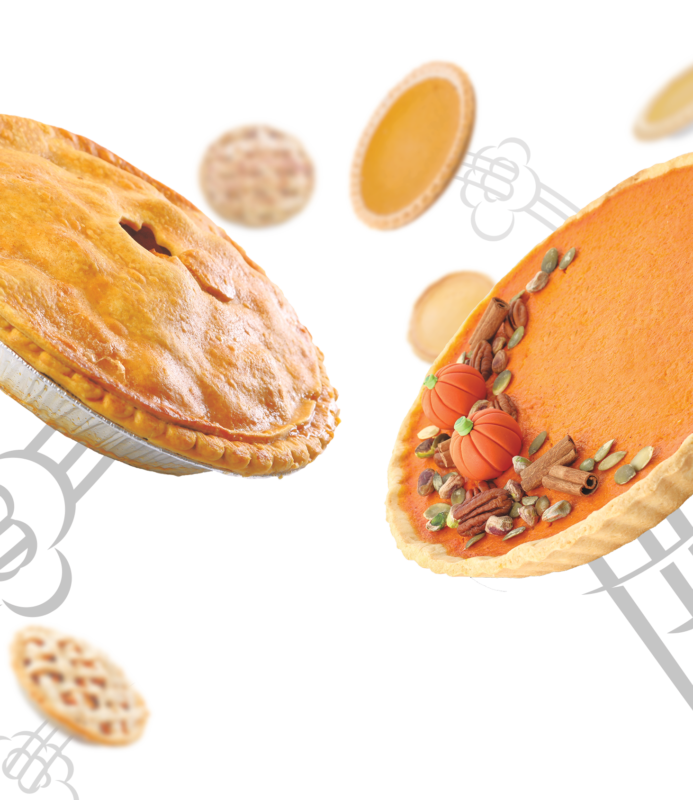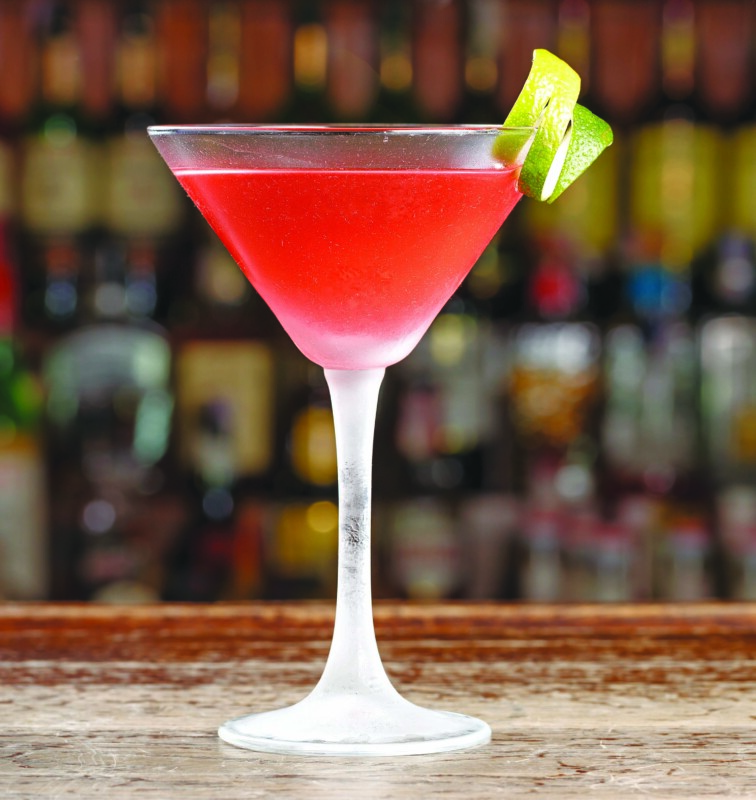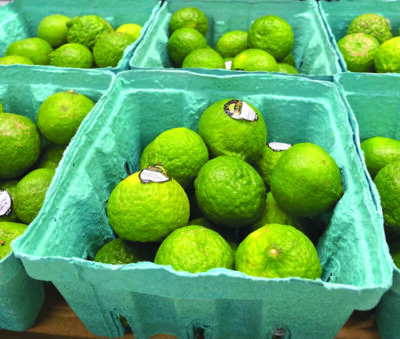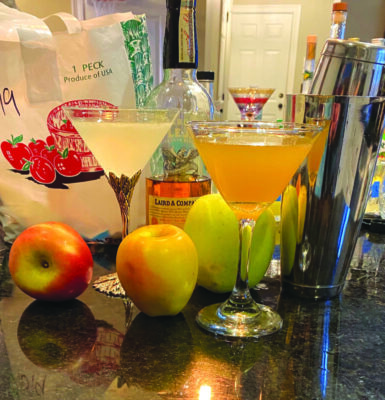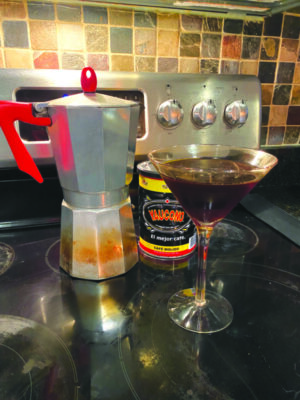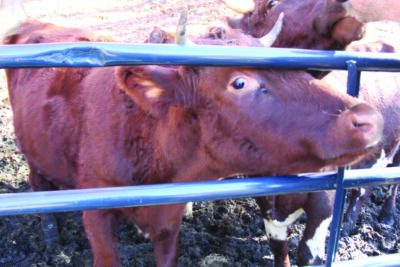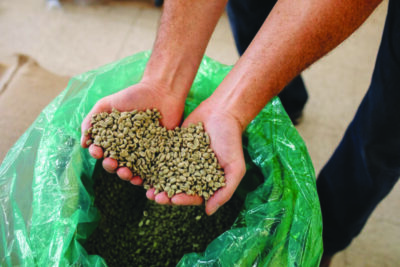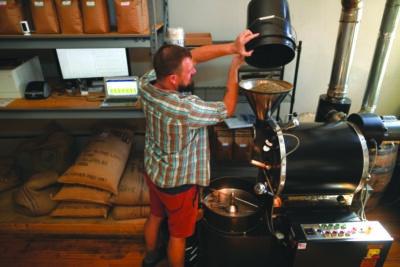APPLE PIE VS. PUMPKIN PIE!
TURKEY VS. NOT TURKEY!
IT’S A FACE-OFF OF THANKSGIVING FAVORITES!
What makes up the perfect Thanksgiving feast? Is it traditional roasted turkey with stuffing, mashed potatoes and gelatinous canned cranberry sauce? But what if you don’t like turkey (or don’t eat meat altogether)? Pumpkin pie is delicious (agrees not everybody) but are there more crowd-pleasing options?
We asked local livestock farmers, butchers, restaurateurs, chefs and bakers to debate some of the key components of the standard Thanksgiving feast and provide tips and recipes into their idea of the best Thanksgiving dishes.
The main event
Turkey or non-turkey — what’s your pleasure?
By Matt Ingersoll
Turkey is the pièce de résistance of the Thanksgiving feast for many — after all, there are so many different ways to prepare the bird, from the traditional method of oven-roasting to simple grilling, spatchcocking, smoking and even deep-frying. The type of turkey you are using, whether it’s a broad-breasted bird or a heritage breed, also plays into how you prepare it.
Karina Allayne of Greetwist Acres in New Boston usually fills orders for both types of turkey. She said broad-breasted turkeys are more likely what you’ll find at the grocery store or major commercial outlet, and are bred to produce much larger breasts — thus, a bird with more meat.
“Broad-breasted [turkeys] are very popular because they clean up really nice … [and] the skin is all white and pretty-looking,” Allayne said. “So, a person might say, ‘You know what, I love broad-breasted because we get a lot of meat on it,’ and that’s what they’re into. … The heritage breeds, those are more closely related to the wild ancestors. There’s not as much meat, [but] a lot of people also feel that heritage … has more flavor, which I agree. Also, there may be an issue in terms of [people saying] ‘Do I want to eat a bird that was only being produced to get fat and die within a year or two’s time,’ because broad-breasted do not usually live past the age of 2.”
When it comes to cooking turkey, Allayne said she now prefers to throw hers on the grill for Thanksgiving after previously preparing it in her home kitchen oven.
“We popped it in the grill one year and it was the best-tasting turkey I’ve ever had, and so from that point on I always grill my turkey,” she said. “[We] cook it somewhere between 350 and 400 [degrees] and then basically it just becomes its own little oven outside.”
Shelley Morley of Mt. Dearborn Farm in Weare similarly likes to grill her turkey, noting that it saves precious oven space in her kitchen for any accompanying side dishes. Last Thanksgiving, she decided to try spatchcocking her turkey, which proved to be, as she said, a “game changer.”
“[Spatchcocking is] when you remove the spine and then flatten the bird, so it cooks more evenly,” she said. “I didn’t even know about spatchcocking until two or three years ago and, of course, with Thanksgiving you always want everything to be perfect. … So last year, there were only five of us, and so I said, ‘Why don’t I try something different,’ when the stakes weren’t as high. I’m going to do it again this year because it just came out so well.”
Non-turkey meat alternatives
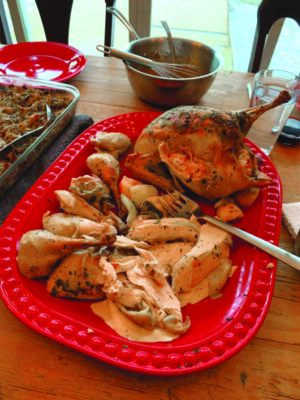
What if you don’t like turkey, or you simply just don’t have the sizable crowd coming over this year to help you finish such a large bird? Both Allayne and Morley will often find themselves selling chickens to customers for Thanksgiving, and Allayne even also sells duck.
“It might just be two people that are getting together, and it’s really hard to find a turkey that is small enough for two people,” Allayne said, “so they’ll order maybe a large roasting chicken. … I do actually sell quite a bit of duck, too, because people want something small, but special.”
As duck meat tends to be fattier, Allayne said it ought to be cooked at a lower temperature for a longer period of time. Duck fat can also be rendered for use in cooking potatoes, she added.
Rob Darling of Concord Beef & Seafood, a premium butcher and fish market on South Main Street, said that while they do regularly sell farm-fresh turkeys around Thanksgiving, he does also end up selling a small amount of spiral-cut hams, as well as prime rib or tenderloin roasts.
“I mean, a roast is a 45-minute to an hour cook, so it’s a lot more manageable [than a turkey],” Darling said. “Beef also has a lot more flavor than turkey, in my opinion, whereas I feel like turkey is pretty much the tradition for Thanksgiving, which is why people have it.”
If you’re cooking a roast, Darling recommends using a meat thermometer to ensure it comes out perfect. For beef specifically, he likes to season with rosemary and garlic powder, in addition to some salt and pepper, to allow the flavor to come through in the meat.
“Beef is actually a lot easier to cook than, say, a pork roast, or even turkey, just because it’s not as lean,” he said. “If you’re cooking something so lean and you overcook it, it’s going to be dry.”
As the shop also does tailor most of its focus to appetizers, Darling said Thanksgiving is also one of the more popular holidays for items like shrimp cocktail, bacon-wrapped scallops and bacon-wrapped tenderloin bites, in addition to some cheeses and meats for platters.
“I think people are just looking for something they can put out and not have to think about. They know it’s going to be good and that people are going to like it,” he said.
Even fresh fish is a viable main course option for some. Elisha Ewing of Liberty Fish, a Peterborough-based business delivering fresh seafood to farm stands and farmers markets in parts of New Hampshire and Massachusetts, said Thanksgiving is a very busy time for her.
She said salmon in particular, as well as haddock, cod and halibut, is among the more popular alternatives to the main turkey dish. Her scallops also prove to be a highly requested appetizer.
“I do think that the majority of my customers probably have turkey as at least one of their main dishes, but I will get orders … from people who are looking for an alternative protein, and so they’ll reach out and order fish,” Ewing said. “I also have folks that will say, ‘Hey, I’ve got friends or family that are going to extend their visit, and I’m really just needing to stock up to do meal prep for the extended holiday weekend.’ … I think some people are basically just maxed out on turkey come Saturday, and they want something else.”
Working with an importer and exporter down in Boston, Ewing always obtains her fish fresh — never frozen. Locally, you can find Liberty Fish at Trombly Gardens in Milford, where Ewing makes weekly deliveries every Wednesday and where pickups are from 2 to 6 p.m. Visit libertyfish.net to join Ewing’s weekly email notification group and order your fresh catch.
A vegan Thanksgiving
Of course, if you simply just don’t eat meat, then you’re likely in store for a whole different kind of main course Thanksgiving option. But, as local vegan and plant-based chefs suggest, that doesn’t mean your holiday feast has to be any less delicious.
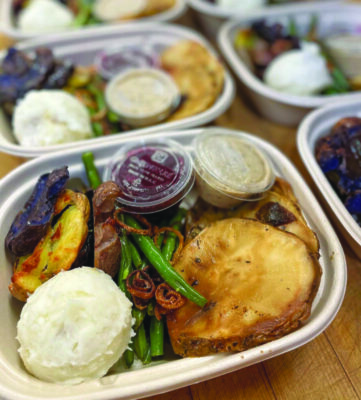
Madeline Rossi and Olivia Lenox of The Green Beautiful vegan cafe in Manchester recently hosted their second annual “gentle Thanksgiving” dinner, a plant-based feast and fundraiser for the New Hampshire Animal Rights League. The couple, who also run New Roots Meals — a plant-based meal prep company — has dabbled in all kinds of unique options over the last few years. Some can even work as “mock turkey” alternatives with similar palates to that of a bird.
“In terms of more of a mock turkey, we’ve done a thing in the past called celeriac. It’s basically just the root of a celery plant,” Rossi said. “They get big and round, and it’s very cool because I’ve done it where it’s sort of in a similar thing that you cook a turkey in, kind of like a stock, and I put it in the oven … and baste it every 30 minutes like you would with a turkey. … It comes out really well and slices really easily. The texture is pretty meaty, but also soft.”
She said the celery root is fairly easy to find — they can be found in most local grocery stores and specialty markets, as she noted that it’s in season during the cooler months.
“The thing is, if you don’t know what it is, you would just walk right past it in the grocery store,” she said. “It’s huge and gnarly and doesn’t look edible, but it very much is.”
Carrie Burt of Joyfull Eats, a plant-based meal company based at Deep Meadow Variety in Exeter, has made a lentil loaf, as well as a chickpea-based “chick-un” loaf that’s also meant to mimic the flavor profiles of a traditional Thanksgiving turkey. Both options, she said, are available to pre-order on her website (joyfulleatsnh.com) through Sunday, Nov. 20.
Other great options, Rossi said, include a white lasagna that’s made with tofu and vegan cheese.
“I feel like doing a white lasagna instead of [with] a red sauce kind of pairs even better with the flavors of Thanksgiving, like stuffing and gravy and green beans and all that stuff,” she said.
“Chick-un” loaf (vegan chickpea-based loaf)
Courtesy of Carrie Burt of Joyfull Eats in Exeter
1 cup onions, diced
½ cup celery, diced
½ cup carrots, diced
4 garlic cloves, minced
3 Tablespoons dried cranberries, chopped up
1 15-ounce can chickpeas
1 15-ounce can cannellini beans
½ cup to 1 cup gluten-free oats
2 teaspoons fresh lemon juice
2 Tablespoons soy sauce (can substitute for tamari or coconut aminos)
1 Tablespoon sunflower butter
2 Tablespoons fresh parsley, minced
1 teaspoon cumin
2 teaspoons poultry seasoning
½ teaspoon salt
2 Tablespoons flaxseed meal (mixed with 2 Tablespoons water)
Preheat the oven to 350 degrees. Saute the onions, celery, carrots and garlic with an oil or broth, until the onions are translucent. Add the chopped cranberries to the pan, mix and let rest. Using a food processor, pulse the beans and oats until crumbly. Add in the rest of the ingredients, including the sauteed mixture, and pulse until fully combined. If needed, add in some extra broth or water if the mixture is too dry — the texture should be a little sticky and it should hold together. Place into a greased loaf pan (or form a loaf on a sheet pan), cover with foil and bake for 30 to 35 minutes. If you’d like to glaze it, remove the foil after 20 minutes and cover with ketchup or barbecue sauce, then cook for an additional 10 to 15 minutes. Let the loaf partly cool before serving.
Celery root roast
Courtesy of Madeline Rossi of The Green Beautiful vegan cafe in Manchester
1 celery root, cleaned
1 large onion, chopped
2 large carrots, chopped
2 cups celery, chopped
8 garlic cloves
1 sprig fresh rosemary
2 cups vegetable broth
Olive oil
For the spice rub:
1 Tablespoon salt
1 Tablespoon pepper
1 Tablespoon thyme
1 Tablespoon oregano
1 Tablespoon brown sugar
1 teaspoon paprika
1 teaspoon garlic powder
Preheat the oven to 325 degrees. Rinse all the dirt off the celery root and clean with the rough side of a sponge. Use a fork to perforate the root, making tiny holes all over to ensure the basting liquid can fully seep in while roasting. Fill the bottom of a deep pan with the chopped vegetables and the vegetable broth. Pour the olive oil all over the celery root, enough to coat, and rub with the spice blend. Place in the pan in the oven for three to four hours, or until cooked through. Baste with the vegetable broth every 30 minutes while the celery root roasts for a deeper flavor. Once fully cooked, slice the celery root into ¼-inch rounds and serve with your favorite sides.
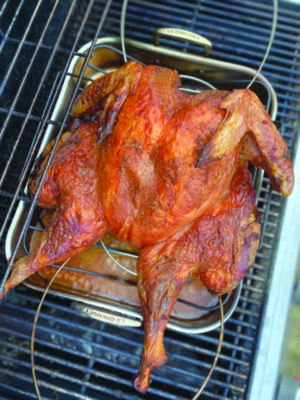
How to spatchcock a turkey
Instructions provided by Shelley Morley of Mt. Dearborn Farm in Weare
• Using kitchen shears, cut from the tailbone along both sides of the turkey’s spine to remove the backbone. (You can use the backbone to make gravy just as you would the neck and giblets.)
• Open up the turkey by pulling it apart where the backbone was removed.
• Turn the turkey over so that the breast is facing up and press down hard on the breast until you hear a crack or two and the turkey can lay flat.
• Place the turkey on a rack on top of a rimmed cooking sheet or broiler pan to catch the juices. You can place some chopped onions, carrots and celery into the pan to help keep the oven moist. They will also add some nice flavor to your gravy.
• Pat dry the skin to encourage extra crispiness. You can also rub the skin with a little olive oil and sprinkle it with sea salt, or season the turkey however you want.
• A 12- to -14-pound turkey roasted at 450 degrees cooks in about 90 minutes — or about seven minutes per pound.
• After the leg meat reaches a temperature of 165 degrees and the breast around 150 degrees, take the turkey out of the oven or off the grill, cover loosely with foil and let it rest for 20 to 30 minutes before carving. Letting the meat rest allows the juices to settle into the meat. This time can also be spent making your gravy and doing any other last-minute meal preparations.
Getting saucy
Jarred cranberry sauce goes toe to toe against homemade
By Katelyn Sahagian
From gelatinous cylinders that hold their shape after slicing to relishes filled with citrus and spices, cranberry sauce can come in a wide variety.
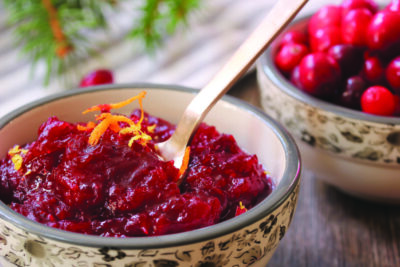
For Kristen Chinosi of The Culinary Playground in Derry, the only option is homemade cranberry sauce.
“I’m homemade all the way,” Chinosi said. “You’re limited with the canned stuff.”
Chinosi said she loves that there’s a personalization that happens with homemade cranberry sauce. She said that there’s a magic behind being able to add different spices and citrus flavors, to personalize the sauce. Even having control over something as simple as the texture of the sauce can make all the difference.
Chinosi did admit that there is a nostalgic factor associated with the easy, can-shaped cranberry sauce. But in the end, there’s no comparison between that and the homemade — and personally customized — version of the condiment.
“It’s fun to see [the berries] pop open. … They do these little explosions,” Chinosi said. “Just cook them down with sugar and orange juice, then slowly add some warm spices, like cinnamon, cloves, allspice and ginger. It’ll smell like fall.”
While Amy LaBelle, owner and winemaker of LaBelle Winery, said she loves a good homemade cranberry sauce, she hopes people will think of her jarred cranberry jam as a viable alternative to people who don’t want to worry about cooking the jellied condiment.
“It’s a lot easier,” LaBelle said. “Just put it in a bowl and let it set up. But it’s still delicious because we still write the recipe.”
The jam, which is a homemade recipe featuring some of LaBelle’s cranberry wine and fresh spices, has many different uses besides as a side dish on the table. LaBelle’s favorite ways to enjoy it are either in a cranberry old-fashioned, with orange bitters and high-quality bourbon, or as the spread for a Thanksgiving leftovers sandwich.
While LaBelle noted that her own sauce wouldn’t need any doctoring to get the spiced, sweet and savory flavor that tastes like fall, she also said that there are a number of good ways to spruce up any jarred or canned sauce.
“If you’re going to buy a can of whole cranberry sauce, you can absolutely take that and add to it some orange zest, orange juices and … definitely add just a tiny bit of clove, some nutmeg [and] cinnamon,” LaBelle said. “But that orange juice and orange zest are really going to be your best way to perk that up. Those, and my cranberry wine, of course.”
Cranberry Jam Bourbon Smash
Courtesy of LaBelle Winery in Amherst and Derry, labellewinery.com
3 ounces good quality bourbon
1½ ounces fresh orange juice
½ ounce cranberry juice
1 teaspoon maple syrup
1 Tablespoon The Winemaker’s Kitchen cranberry wine jam
Dash of blood orange bitters
Place all ingredients in a shaker over ice and shake for 30 seconds. Pour with ice into a highball glass rimmed with cinnamon sugar.
“Your” Cranberry Sauce
Courtesy of The Culinary Playground in Derry, culinary-playground.com (yields about two cups)
1 teaspoon orange zest
½ cup fresh squeezed orange juice (from 1 large orange)
12 ounces fresh or frozen cranberries, divided
½ cup water
¾ to 1 cup packed brown sugar
Optional add-ins:
Up to ½ teaspoon cinnamon and/or allspice
Up to ⅛ teaspoon ground ginger and/or cloves
Up to ½ cup toasted pecans and/or walnuts, chopped
Up to ½ cup dried apricots and/or dates, chopped
1 Granny Smith apple and/or D’Anjou pear, peeled, cored and chopped
Zest the orange to yield 1 teaspoon, then set aside. Cut the orange in half and juice it to yield ½ cup. Measure out ½ cup of cranberries and set aside. Add the remaining cranberries into a medium saucepan set over medium heat. Add the water, orange juice and brown sugar. Stir occasionally as the mixture comes to a simmer. Once simmering, reduce heat to medium-low. While stirring occasionally, continue to cook until the liquid has reduced and the cranberries have burst and thickened (about 10 more minutes). Decrease the heat to low and stir in ½ cup reserved cranberries and orange zest. Taste and add additional brown sugar if it’s too tart. Remove from the heat. If customizing your sauce, stir in those ingredients as well (except for any nuts). Transfer to a serving bowl and allow to cool and thicken. Once cooled, cover and refrigerate for at least a few hours, or up to a week. Bring to room temperature before serving. If using nuts, stir them in before serving.
Potato vs. potato
Traditional mashed takes on sweet potato
By Angie Sykeny
Mashed potatoes: the flavor conveyor
Everyone has their preferred Thanksgiving side dishes, but for Brandon Rainer, co-owner of The Potato Concept in Derry, there’s one dish that should make it onto every plate.
“Mashed potatoes. One hundred percent,” he said. “That’s the ultimate side dish. Thanksgiving just isn’t Thanksgiving without it.”
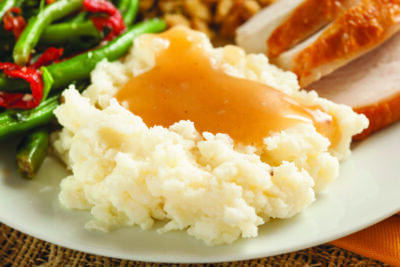
And the simpler they are, the better; Rainer’s high praise for mashed potatoes, he said, comes from the dish’s unique ability to act as a “vessel” for the medley of flavors on your plate.
“You can take your fork, take a little bit of turkey, take a little bit of cranberry sauce, and take it in with your mashed potatoes,” said The Potato Concept co-owner Lauren Lefebvre. “You’re able to play with different textures and flavors on your plate and make different combinations, which is fun.”
Mashed potatoes can also serve as a “holder” on your plate for whatever you want to combine with the potatoes — and for the foods that you want to keep contained from the rest.
“My kids like to make what they call a ‘gravy pond,’ where they make a little space in their potatoes to hold their gravy,” Lefebvre said.
Be sure to leave a bite or two of mashed potatoes for last to soak up all the remnants of Thanksgiving goodness.
“It’s the perfect way to clear your plate,” Rainer said.
Preparation tips
The first and most important step for making good mashed potatoes, Rainer said, is to use real potatoes, never boxed.
“That’s the biggest way where you can go wrong,” he said. “You have to have the real thing. Nothing else will substitute for it.”
If you’re boiling your potatoes, patience is key. Plan the rest of the meal so that you have a burner reserved for potatoes to give them the time that they need to cook thoroughly.
“A lot of times, people have a lot of different things they need to cook, and they get impatient and take the potatoes off as soon as they can slightly put a fork through them,” Lefebvre said, “but once they go to mash them, they find that the potatoes are still very much hard in the center.”
Mash as you might, there will still be chunky bits, so those few extra minutes on the stove are always worth it.
“They’re supposed to be creamy. Nobody likes to have to chew on their mashed potatoes,” Lefebvre said. “That can throw off the dish completely.”
Sweet potatoes: a dessert before dessert
Sweet potatoes are the better option if you’re looking to add a bit of variety to the traditional Thanksgiving lineup.
“Thanksgiving has a lot of savory items and a lot of salts, but there’s not a lot of sweet things you can add, aside from maybe cranberry sauce,” Lefebvre said, “but sweet potatoes bring that bit of sugar to diversify the flavor profiles on the table.”
You can bake sweet potatoes and serve them whole, bake them into sweet potato fries, or, for a custard-like treat, you can mash them.
“That by itself would be pretty indulgent,” Lefebvre said, “but, of course, you can always get fancier with it.”
Amp up the sweetness with toppings like brown sugar or marshmallows, or, if you want some additional flavor without the additional sugar, try spices, like cinnamon or nutmeg.
“It adds a bit more to the flavor profile of the sweet potato,” Lefebvre said.
Preparation tips
Sweet potatoes tend to be softer than the russet potatoes typically used for mashed potatoes, which means less prep time. The downside is their potential to get messy.
“If you’re baking them, and they start to pop and explode and leak everywhere, that [juice] will caramelize and burn quickly and create a mess in your oven and make for a kitchen nightmare,” Rainer said.
To prevent, or at least minimize, such a mess, simply poke some holes in the potatoes with a fork before putting them in the oven.
“Some people say you shouldn’t poke the potatoes, but after experimenting with many, many, many potatoes this year, we’ve found that, with sweet potatoes, the poking is necessary,” Rainer said.
Ginger sweet potato
Batch of five
Courtesy of The Potato Concept
5 sweet potatoes
½ cup butter
1 cup brown sugar
15 gingersnap cookies
¼ cup maple syrup
2 cups mini marshmallows
1 teaspoon salt
Get good quality sweet potatoes — ones between 1/2 and 3/4 pound work best. Stay away from ones where the skins and the ends of the potato aren’t fully intact. Preheat the oven to 375 degrees. While it’s coming to temp, poke each potato a few times with a fork. Put them directly on the oven’s wire rack. Make sure there’s a pan underneath to catch the drippings, which may start to leak out toward the end of the cooking process. Bake for 50 to 55 minutes. Take the potatoes out of the oven using tongs and let them rest for 5 to 10 minutes. Set your oven to broil.
While they’re cooling, cut 1/2 cup of butter into smaller pieces and put them in a mixing bowl. Add a cup of brown sugar and a pinch of salt. Once the sweet potatoes have cooled slightly, slice them lengthwise and carefully scoop out the insides while doing your best to keep the skin intact. Add it to the mixing bowl. It should still be hot enough to easily melt the butter. Use a fork to hand blend the ingredients. Scoop the mixture back into the sweet potato skin.
Place the mini marshmallows on top of the potato and put them back in the oven on a sheet pan on the top rack. Keep a close eye on them as you’re just looking to brown the marshmallows, and it shouldn’t take more than a minute or two. Once browned, remove from the oven.
Take 10 of your favorite variety of silver dollar sized gingersnap cookies and smash them into crumbs using a food processor or a hammer. Top the potatoes with the crumbs and save five cookies to put directly into the potato whole, as pictured. Then, take a teaspoon of maple syrup and drizzle on top.
Any way you slice it
Apple versus pumpkin — which pie takes the cake?
By Mya Blanchard
On the question of apple pie versus pumpkin pie, Christiana Lehman, owner of From Gracie’s Table in Brookline, is 100 percent Team Apple Pie.
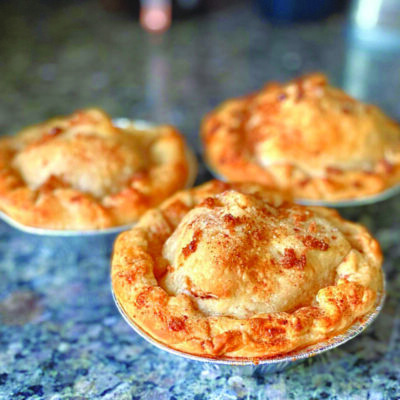
“Pumpkin is gross,” Lehman said. “I make it because I know people eat it, but I do not even know what my own pumpkin pie tastes like because I do not like pumpkin pie.”
Local food blogger and chef instructor Liz Barbour, of The Creative Feast in Hollis, also picks apple.
“I personally like an apple pie better. … I like the texture of the apples, the different flavors of the apples and it’s a family favorite at our house,” she said.
On the other hand, Lisa Lucciano of The Cake Fairy in Hooksett doesn’t have such strong feelings.
“Personally I don’t [have a preference]” she said. “I like them both. … I probably would always choose pumpkin pie because it’s only made usually at Thanksgiving and Christmas … if I was only able to eat one I would eat pumpkin pie at Thanksgiving.”
While pumpkin pie might not take the cake as the fan favorite, it’s generally easier to make than apple pie, as it requires fewer steps and less preparation.
“[Apple pie] does require more effort because you have to peel them, then you have to mix the stuff [in] the apples, then you put it in the crust and fix the crust and decorate the crust,” Lehman said. “But with pumpkin … you open a can, you mix in the spices … and you put it in the crust.”
Barbour simplifies the apple pie making process by skipping the step of peeling the apples.
“[With] a properly baked apple pie, the way you can tell if it’s baked enough … is when you look at your pie at the end of the baking, the filling should be bubbling up through the vent holes,” Barbour said, “and that way you know that the skins have broken down [and] the apples are softened.”
When choosing which apples to include in your pie, variety is the key.
“You’re going to be looking for apples … that are sweet, apples that are tart [and] apples that add texture,” Barbour said. “When you combine all of those, then you have a really nice flavor base as opposed to using just one type of apple.”
Apple pie also wins the category of versatility.
“I think you can be more creative with an apple pie. … The apple pie is absolutely more versatile,” Lucciano said.
No matter which pie you choose to serve at Thanksgiving, it’s important to make it with care.
“You have to make sure that it’s spiced just right, mixed just right and in proper ways too,” Lucciano said. “Baking is a science that people don’t realize. If there are directions on how to do things, follow them.”
“Oh my!” apple pie
From the kitchen of Christiana Lehman of From Gracie’s Table and Brookline’s Finest
2 pie crusts
8 apples
1 10-ounce container From Gracie’s Table “dry” apple pie mix (includes brown sugar, cane sugar, cornstarch, white flour, ground cinnamon, nutmeg and sea salt)
2 Tablespoons butter
Lay out the crust into the bottom of a pan. Peel and chop apples. Mix dry ingredients with apples and butter. Pour seasoned apples into the pie crust. Cover with the other pie crust and pinch the edges together. Make three small slits on the top to vent. Cook at 425 degrees for 30 to 40 minutes.
Pumpkin apple custard pie
Courtesy of Diane Souther of Apple Hill Farm in Concord
8 medium-sized apples, peeled, cored and sliced
1 ½ cups pumpkin puree
3 eggs, separated
½ cup white sugar
½ cup maple sugar (or light brown sugar)
½ cup maple syrup
3 Tablespoons flour
1 Tablespoon cinnamon
¼ teaspoon pumpkin pie spice
¼ teaspoon salt
2 ½ cups warm whole milk
2 9-inch unbaked pie crusts (can use graham cracker crusts)
Preheat the oven to 375 degrees. Make your favorite pie crust and place in two pie plates, or use store-purchased crusts. Peel, slice and core the apples. Line the inside of the bottom of the 9-inch pie crusts. Separate the eggs, yolks and whites, and beat the whites until stiff, then set aside for later. Mix the yolks with the pumpkin puree, then add the white and maple sugars, the maple syrup, the flour, the salt and the spices and mix well. Add the warm whole milk (not hot) and mix well. Gently fold in the egg whites. Divide the mixture in half and gently pour between the two pie plates. Bake at 375 degrees for approximately 15 minutes, then give them a spin and reduce the heat to 350 degrees for about 30 minutes longer, until the custard is set and no longer loose.
Featured photo: Courtesy photo.

